Related Research Articles
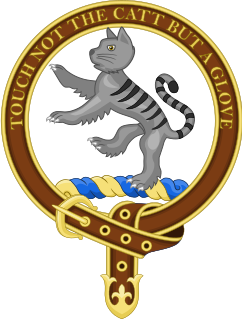
Clan Chattan is a unique confederation of Highland clans. The clan is distinctive in highland clan history in that it was acknowledged to be a community or confederation, of twelve separate Scottish clans, who each had their own clan chief recognized under Scottish law, but who were united under and bound to a superior chief of the confederation for mutual solidarity, sustenance and protection in the Middle Ages and early modern period in the Scottish Highlands.

Clan Mackintosh is a Scottish clan from Inverness in the Scottish Highlands. The chiefs of the clan are the Mackintoshes of Mackintosh. Another branch of the clan, the Mackintoshes of Torcastle, are the chiefs of Clan Chattan, a historic confederation of clans.
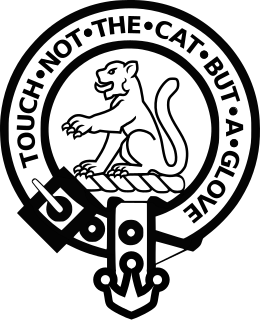
Clan Macpherson is a Highland Scottish clan and a member of the Chattan Confederation.

Clan Cameron is a West Highland Scottish clan, with one main branch Lochiel, and numerous cadet branches. The Clan Cameron lands are in Lochaber and within their lands lies Ben Nevis which is the highest mountain in the British Isles. The Chief of the clan is customarily referred to as simply "Lochiel".

Clan Davidson is a Highland Scottish clan and a member of the Chattan Confederation.

Clan Anderson is a Scottish clan that is recognized as such by the Lord Lyon King of Arms. However, as the clan does not currently have a chief recognized by the Court of the Lord Lyon, it is therefore considered an armigerous clan. Variations of the surname are however considered septs of several other clans of the Scottish Highlands: The surname MacAndrews is considered a sept of the Clan Mackintosh and Clan Chattan, and also associated with the Clan MacDonell of Glengarry. The surnames Andrew and Andrews are considered septs of the Clan Ross.
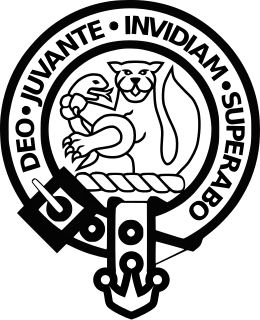
Clan MacThomas is a Highland Scottish clan and is a member of the Clan Chattan.

Clan MacBean, is a highland Scottish clan and is a member and historic sept of Clan Chattan.

The Battle of the North Inch was a staged battle between the Clan Chattan and the "Clan Quhele" in September 1396. Thirty men were selected to represent each side in front of spectators, including King Robert III of Scotland and his court, on land that is now the North Inch park in Perth, Scotland.

Clan Macqueen is a Highland Scottish clan and a member of the Chattan Confederation. The clan does not currently have a chief and is therefore considered an Armigerous clan.
The Mackintoshes of Borlum were a cadet branch of the Clan Mackintosh, a Scottish clan of the Scottish Highlands. Their most famous member was Brigadier William Mackintosh, Laird of Borlum (1658–1743) usually known as Mackintosh of Borlum who was a leader of the Jacobite rising of 1715.
Manrent refers to a Scottish contract of the mid-15th century to the early 17th century, usually military in nature and involving Scottish clans. The bond of manrent was commonly an instrument in which a weaker man or clan pledged to serve, in return for protection, a stronger lord or clan—in effect becoming a vassal that renders service to a superior, often made in the form of a covenant. Manrents were a Promise by one person to serve another, [such] that he shall be friend to all his friends, and foe to all his foes.

The Battle of Invernahavon was a Scottish clan battle between the Clan Cameron and the confederation of Clan Chattan that consisted of the Clan Mackintosh, Clan Macpherson, and Clan Davidson. Some sources give the date as 1386, others as 1370.
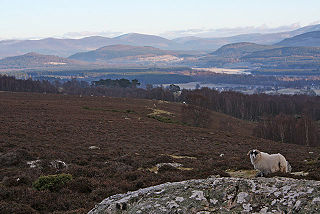
Dunachton is an estate on the north-west shore of Loch Insh in Badenoch and Strathspey, in the Highlands of Scotland. It occupies land immediately to the north of the A9 road and General Wade's Military Road.

Clan Cumming, also known as Clan Comyn, is a Scottish clan from the central Highlands that played a major role in the history of 13th-century Scotland and in the Wars of Scottish Independence. The Clan Comyn were the most powerful family in 13th-century Scotland, until they were defeated in civil war by their rival to the Scottish throne, Robert the Bruce.

The Battle of Craig Cailloch was a Scottish clan battle fought in 1441 between the Clan Cameron and Clan Mackintosh. The two clans had defected from Alexander of Islay, Earl of Ross during his war with James I of Scotland. Alexander lost the war but was subsequently appointed Justiciar of Scotia by James and became reconciled to the Chattans. Alexander encouraged the Chattans to invade the lands of the Camerons which resulted in a battle on Craig Cailloch in 1441. The battle was bloody and several leading Chattan men were killed. Afterwards Malcolm Mackintosh led further raids into Cameron territory to avenge the deaths. Donald Dubh, leader of the Camerons was later forced into exile in Ireland.
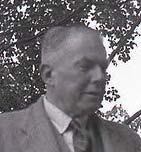
Duncan Alexander Eliott Mackintosh of Mackintosh-Torcastle and Clan Chattan was the 31st Chief of Clan Chattan, a confederation of Scottish Highland Clans. As a result of the 29th Chief's preferment of a more distant cousin and Arbell Mackintosh becoming the 30th Chief until her marriage to Anthony Warre it devolved on the 29th Chief's next heir in line, Duncan Alexander Eliott Mackintosh by the order of Lord Lyon King of Arms issued on 27 March 1947 who became 31st Chief and matriculated ‘as of right and without brisur or mark of cadency Ensigns armorial of and appropriate to Mackintosh of Mackintosh-Torcastle and Clan Chattan, marshalled as effeirs for the Inheritor of the Honourable the Clan Chattan… as Head of the ‘‘haill kin of Clan Chattan’’’. At this juncture the chieftainship of Mackintosh and Clan Chattan split.

Clan MacPhail or the Sons of Paul is a Scottish clan of the Scottish Highlands. Known in Scottish Gaelic as Conchie Dhu or Condochy Doye, the clan is mainly associated with the confederation of Clan Chattan.
Ferquhard Mackintosh, 12th of Mackintosh was the chief of the Clan Mackintosh, a Scottish clan of the Scottish Highlands. He was also chief of the confederation of clans known as the Clan Chattan.
William Mackintosh, 13th of Mackintosh was the chief of the Clan Mackintosh, a Scottish clan of the Scottish Highlands. He was also chief of the confederation of clans that was known as the Clan Chattan.
References
- 1 2 3 4 Browne, James (1840). A History of the Highlands and of the Highland Clans. Vol. 1. Glasgow: A. Fullarton. pp. 153–156. Retrieved 12 November 2019.
- ↑ Mackintosh-Shaw, Alexander (1880). "IV". Historical Memoirs of the House and Clan of Mackintosh and of the Clan Chattan. London: printed for the author by R. Clay, sons, and Taylor. p. 98 . Retrieved 12 November 2019.
- 1 2 3 Keltie, John S F.S.A. Scot (1885). History of the Scottish Highlands, Highland Clans and Scottish Regiments. Vol. 1. Edinburgh: T.C. Jack. p. 67 . Retrieved 12 November 2019.
- 1 2 3 4 5 6 Fraser-Mackintosh, Charles (1898). An account of the confederation of Clan Chattan: its kith and kin. Glasgow: J. Mackay. p. 118-121. Retrieved 12 November 2019.
- ↑ Mackintosh-Shaw, Alexander (1880). "IV". Historical Memoirs of the House and Clan of Mackintosh and of the Clan Chattan. London: printed for the author by R. Clay, sons, and Taylor. pp. 103-105. Retrieved 12 November 2019.
- ↑ Scots Kith & Kin. HarperCollins. 2014. p. 78. ISBN 9780007551798.
- ↑ by Frank Adam, first published 1908
- ↑ Chapter III The Highland Clan System under the Royal Stewarts and down to the Battle of Culloden
- ↑ Chapter III, p.56 of the sixth edition